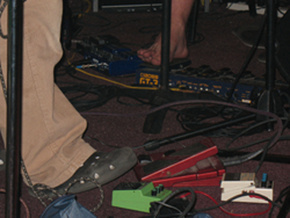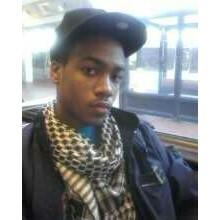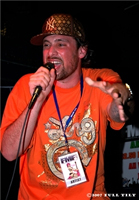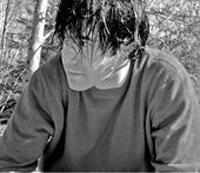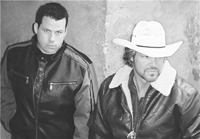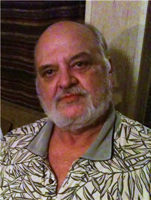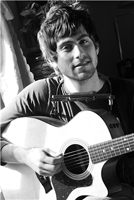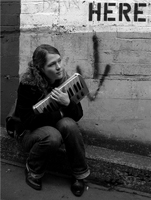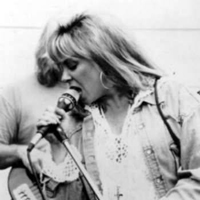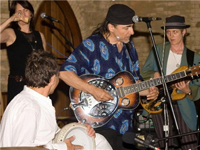My apologies for the lateness of this month’s Music Up Close. I’ve been reveling in unheard of 50 degree temperatures up her in the Northern Plains where I live AND working on details for my debut as a fiction author. The Bowdancer, my novelette, will be published as an ebook by Breathless Press later this month and I’ve just had my hands full here.
I have some breathing space now and can bring you a couple of really interesting features in the Music Up Close venue. Back Stage offers an extensive interview with Donovan Leitch, who is the lead singer with the band Camp Freddie (and the son of Scottish folksinger Donovan and sister of actress Ione Skye). We’ll be talking about his project with C. Allbritton Taylor (Courtney Taylor), the principal songwriter and lead singer/guitarist for The Dandy Warhols, called One Model Nation, a new graphic novel. Then in The Studio, I’ll introduce you to a bright new singer/songwriter from northwestern Minnesota, Teague Alexi, who, along with his brother Ian, form the band The Hobo Nephews of Uncle Frank. Originally from New Jersey, the Alexi brothers have a new CD and DVD out. Finally, we’ll do our usual tour through the SonicBids Lounge and see what new talent we can scurry up as we work the room.
So, come on in, and let’s get up close with music.
Back Stage
Donovan Leitch Talks About New Model Nation
I caught up with Donovan Leitch recently to discuss his new project with Courtney Taylor, the graphic novel, New Model Nation, that was just released November 11, 2009 by Image Comics. Leitch was the historian for this graphic novel and brings insight to the work.
[You can read the review of the book I did for Midwest Book Reviews on Reviews by Janie here http://janie7722.wordpress.com]
As I did with last month’s interview with Jim DeRogatis, I am resorting to another Q&A, a format that I think keep’s Letich’s words fresh.
Janie: This graphic novel is considered historical fiction, correct?
Donovan Leitch: I don’t think we’ve invented that term, but that’s what we’re going with. It’s inspired by actual events. Courtney and I had been had been working on this story for a good ten years. We’re old friends. We’re both musicians, and we’re both huge fans of this era in which the story is set, which is Germany 1977. Kraftwerk was sort of being there and pushed as sort of the leaders of the electronica movement. [Kraftwerk was a German band that influenced a lot of UK musicians with its use of synthesizers, catchy melodies, and repetitive rhythms.] People like David Bowie and Iggy Pop were traveling to Berlin to be a part of the scene. It was a very exciting time.
As we began researching it, we realized that there was this whole political/terrorist upheaval going on during the time with the Red Army Faction, which later became known as the Baader-Meinhof Gang. We thought, ‘Wow. That’s pretty cool.’ Why don’t we do a story about a band that was just trying to be a band and make music in the middle of this crisis that’s going on in the country where on one side was the government, the secret police, the Stazi, trashing their studio and calling them terrorists and trying to shut down their gigs. And on the other side, you have a group of fans that loved the band but they’re affiliated with the terrorists. The band is kind of stuck in the middle, being artists who don’t really give a crap about any of it and they just want to make music. That’s sort of the basis of the story.
Janie: This story, I gather, has never been told. It does mirror other artists in other places of the world throughout history. There have been artists that have fallen under the bus just as they did during the McCarthy era in the 50s with the Red scare.
Donovan Leitch: Yeah, sure, some of Hollywood’s greatest screen writers and directors. Definitely. It’s got that feeling to it.
Janie: You’ve been brainstorming this idea for ten years. How did this all come together then? How did you enlist Jim Rugg, who is quite well known, to illustrate this book. [Jim Rugg is best know for his Afrodisiac and Street Angel books.]
Donovan Leitch: We originally had written a screenplay. When Courtney and I put together the story, we had taken six months or so and wrote a script we were pretty happy with. Then, we started taking it out to different people. We’d given it to George Miller to read. He did the Mad Max movies. And, we’d given it to actor friends and Julian Temple who made the Sex Pistols documentary and lots of writers and directors who we really thought might get the visual. It’s not that easy to get a script produced. So, there were times we kind of lost faith and put it on the back burner. And, of course, Courtney’s band, the Dandy Warhols, is very successful. He would go off and make record and we’d kind of come back to it again.
It was really Courtney’s idea to introduce it into the comics realm because he has a friend who’s a comic book illustrator. The script got into the hands of the people at Image Comics. When they read the script, Michael Allred and Joe Keatinge, who were the producers on the book, said, ‘This is an amazing graphic novel that you’ve got here.’ They went to Jim Rugg who is one of their top illustrators. Jim read it and actually put aside another project that he was working on and said, ‘This is amazing. I want to get right into to this.’ He started sketching the characters, and he and Courtney storyboarded it together. Really, I credit Courtney for putting the whole graphic novel together because I think we had just kind of reached the end of the rope with the screenplay.
Then all of a sudden it took off. It was great because Jim Rugg was doing sketches of our faces because we were the inspiration for what the band looked like–Courtney, myself, this guy John Fell who is also the colorist for the novel, and another friend of Courtney’s. We kind of became the defacto image of the band, only we look a lot younger and cooler in the book. [laughs]
Janie: [laughs, too] That’s always nice. That will be something for readers and fans to look at in the book. That’s a nice little lure to get them curious. I think what is interesting about a graphic novel is you will reach the audience you wanted to anyway, the age range (and maybe broader) and the people interested in your music.
Donovan Leitch: We went to Comic-Con this year because Image Comics announced the book. We’re all comic book geeks at heart anyway. I’m a huge fan of graphic novels and Courtney is as well. Believe it or not, he kept referring to Star Wars when we were writing the script. He kept saying, ‘I want it to be as clean as Star Wars.’ That’s definitely setting your sites high. He set the bar high, but I think that we reached it because it has certain universal themes to it.
It is a story set in Germany in the late 70s, but it is this sort of struggle between art and politics. What I found so interesting about the Baader-Meinhof Gang and also about this era is this generation was sometimes called Hitler’s children because these were the sons and daughters of the Nazi generation.
A lot of Germans were reluctant to join the party, but they would be killed or imprisoned if they didn’t. We actually have a character, one of guys in band, whose father is living in the Bavarian Alps somewhere. We sort of allude that he was a professor who was coerced into doing some horrible deeds for the Nazis. And his son says to him, ‘I’m going to quite the band. They think we’re terrorists, Dad. I just want to make music.” And the dad says, ‘Well, at least you didn’t have gun to your head like I did. You have a choice. I didn’t have a choice.’ So we bring up that struggle.
What was happening, too, at that time in Germany, was what they called the Wershaft Wonder, which means the ‘economic miracle.’ This was where Germany began to embrace Western capitalism. That was where a lot of the terrorist acts came out of; it was the opposition to that. They didn’t want to go down that road. It was happening all over the world. It was happening in France. It was happening here with Patty Hearst. There were these sort of radicalized terrorist organizations all over the place. It was a very electric time.
Janie: How did you do your research for this? Did you do a lot of reading and digging and talking to folks?
Donovan Leitch: Yeah, we did. I pretty much saw every film that was made on Baader-Meinhof. Fasbender, who is a great German director, made that movie Berlin. Alexander Plots, which were actually several German directors. They all did a take on Baader-Meinhof. There’s a film out right now called the Baader-Meinhof Complex that was nominated for an Academy Award this year for Best Foreign Film. There have been lots of really interesting books written. This one by Astrid Kole, who was in the Baader-Meinhof Gang. She was a photographer and she has a book out called Pictures on the Run: Life with the Baader-Meinhof Gang. I gave that book to Jim Rugg, and he got a lot of images and inspiration from those photographs.
I read some books and then we kind of used Kraftwerk a little bit as inspiration. I read a couple of Kraftwerk biographies. There were very secretive. They didn’t have a fax machine. They would use a payphone at end of street. They never allowed visitors into their recording studio. They never wanted people to see how they worked so I thought, from the outsider, like the secret police, if you are so secretive about what you’re doing, the police might think you were making bombs or something when in actuality, you were just making music.
I thought, ‘Wow. It’s really interesting that these guys who lead a very reclusive life because they want to protect their artistic integrity are going to be mistaken as being terrorists.’ So, that was one of the plot twists in the story. And that stuff really happened to Kraftwerk. A couple of times, their studio was actually raided by the police because of some old war widow living across the street. They were already suspect because there were posters all over Germany, wanted posters of the Baader-Meinhof Gang, and they were just 20 faces of young kids. They could have been anybody. So, the whole country was living in fear that buildings were going to be blown up. It was a very real thing.
Janie: You pulled all of this together, and you and Courtney crafted your screenplay. Then from that Jim Rugg had his basis of where to go with it. Obviously, Courtney must have done some tweaking with the dialog to make it fit the sketches, I would assume.
Donovan Leitch: Yes. It didn’t change all that much from the script to the novel, but there definitely were changes. And Courtney is a great lyricist. He wrote every line of dialog in the script. I did more of the story arc and the character arc and things like that. That’s more my expertise. He’s the voice of the characters. He worked really well with these guys. Courtney has been so hands-on. Not only that, Courtney has pretty much financed this entire graphic novel every time something needed to be done. The reason that it’s sort of been fast-tracked is because Courtney stepped up pretty much as a producer. He’s really put his money where his mouth is.
So, there were minor changes. The first four or five pages of the novel are drawn by a different artist, a friend of Courtney’s. His name is Cary Porter. We wanted the opening to be different. It’s drawn in black and white. The character who is based on Courtney is meeting the character that is based on one of the Kraftwerk members. He says to the Courtney character, ‘You shouldn’t make a movie about us because you weren’t there and you don’t know what it’s like. Why don’t you just make your own story?’ That sort of sets the Courtney character off into a sort of fantasy world of what might have been that becomes the story. At the end, it sort of flashes to the present time again where the Courtney character has this meeting, that really happened with one of the Kraftwerk members in 2003, I think, backstage at a concert. That’s kind of where that tie-in is.
Janie: You’re hope for this graphic novel is what? To tell a story about art versus politics?
Donovan Leitch: For me, really the theme is how to persevere as an artist and to stay true to your artistic form no matter what. You made a good point earlier. It doesn’t happen so much in the US, but certainly overseas musicians are oft times thrown under the bus. If you look at African musicians sometimes, 95 percent of the music is about the struggles and so much that is going on politically, socially, economically. They don’t write that many love songs.
Another thing, too, we went up to Courtney’s studio, and we recorded the One Model Nation record that we’re going to be putting out right after the graphic novel comes out. The music is very influenced by the novel obviously. We did it in four days. It was so fun! We just stayed up and recorded music and walked away with 11 tracks. We want to go to the next Comic-Con, and we want One Model Nation to perform there. We want to be something totally out of the box.
I think we’re the first graphic novel that has an actual tie-in with a record. If not the first, then certainly one of the few.
Janie: I don’t think I’ve heard of it happening before and then to actually have a real band that would be able to perform.
Donovan Leitch: That’s the cool thing, too. We’re musicians. That’s what we are first before writers.We are musicians. For us, it make perfect sense that we make a record.
Janie: What I think will happen here once the buzz gets going about this, not only through the graphic novel and the comic conventions, is I think you may get your shot to have this brought to the screen.
Donovan Leitch: I really hope so. I was thinking there are a lot of production companies, studios, and agencies that now have people that specialize in taking screenplays and adapting them to graphic novels and then adapting them back to screenplays again. That’s what we’re doing. But what we did was unintentional. It wasn’t some CAA decision. I hope you’re right.
I’m really excited that once when we get the finished copy of this in our hands, I know what I’m giving all my friends for Christmas.
Janie: I’ve seen this happen with Gregg Hurwitz who is a NY Times bestselling thriller writer who also writes graphic novels. A lot of his thrillers have been optioned, but the graphic novels he writes are optioned, too. We can see that happening. Now that that’s become a big thing with Marvel and others who are bringing out the classics like Spiderman and even the Watchmen. And they are taking a new look at this sort of thing. It wasn’t just something you did but didn’t want to tell people that you wrote a graphic novel. There is some really good talent out there.
Donovan Leitch: Absolutely. I know that it’s going to attract talent as well. There are some relationships that we have alreaady. Some of the artists that read the script loved it—The Strokes, Keanu Reeves, Drew Barrymore, Crispin Glover, Peter Sarsgaard. We gave the script to a lot of people. They looked at it and told us, ‘This would be the funnest movie to be a part of it.’ It was just really hard to explain. But now that it’s a graphic novel, people can pick it up, look at visuals of it, and get it.
That’s what we want to do once the book comes out, once the record comes out is focus our attention back on making a movie.
Janie: I think it will happen. It may be an independent film. That’s OK, too.
Donovan Leitch: Yeah. Courtney has a great idea for a sequel as well. I’ll give you a little teaser, and we’re going to start writing it. After the war, South America became a hideout and a haven. We know that we want to set it in a South American city, which I think would be a really cool space to put it in.
I’m reading this book now called The Informers, which is about that.
Janie: Donovan, this has been absolutely wonderful to get into the heart and soul of this graphic novel.
Donovan Leitch: Well, thank you.
The Studio
Hobo Nephews of Uncle Frank
Traveling Show
Independent
It’s been said that the winters in our north country can change a man. For Teague Alexy, the front man for Hobo Nephews of Uncle Frank, the pine forests of Holyoke, Minnesota and the trains that run by his home, changed not only something deep within him but also his music.
Teague and his brother Ian grew up in southern New Jersey and finished high school in . Ian went off to the Berkeley School of Music and eventually studied drums and guitar in Africa for a year. Teague stayed stateside, spent some time in San Diego, and returned to New Jersey to play in a band called Spilled Milk. Eventually, he followed a beautiful woman into what was, for him, a wilderness. Here, he found something lasting and rich that has colored his musical soul and influenced his journey as a songwriter and musician.
Teague began to sit on his porch in the pine forests of Holyoke, Minnesota, and let the land speak to him. That changed him to the core, causing him to rethink his musical journey and set aside some of his earlier musical influences, mainly hip-hop, reggae, and jazz. “After living in Minnesota for awhile, the rootsy music of this country started to sound better to me than it ever did on the beaches of San Diego or in Atlantic City, New Jersey,” Teague said. “Living out in the woods, suddenly that music started to make more sense to me.”
Following in his namesake (a teague is an Irish wandering bard), he wrote about the countryside, the people around him, and what he thought of about it all. He formed Teague Alexy and Medication as a vehicle for his new roots writing style. As Teague wrote and recorded his new music, he sometimes did a solo act as Teague Alexy with Medication. “When I first came, I played with a percussionist and an acoustic bass player. That evolved into a full band with drums and electric guitar,” Teague said. He started the Feelin’ Band, which is now fronted by Nicholas Mrozinski. Under Teague, that band released a disc that produced a more rocking roots music. “It’s piano, upright bass, guitar, and drums. It has a little more swinging New Orleans, funky kind of thing,” Teague explained.
When his brother Ian moved to Duluth, about thirty miles north of Holyoke, they formed Hobo Nephews of Uncle Frank. The band name wasn’t some quirky, countryeque tag that these East Coasters thought might appeal to folks in the Iron Range. It derived from their frequent gigs across the country when they had to sleep in the basement of their Uncle Frank’s house. Around their uncle, they always referred to themselves as his hobo nephews because they were always on the move.
As Teague continue to write, he wanted to capture more of what Minnesota was doing to him. “The Hobo Nephews songs came from me sitting out in rural northern Minnesota on my back porch and playing. Those are the songs that I wanted to sing here. The songs that I’d written on the cliffs in California didn’t sound as good when I was playing them in my backyard,” Teague said. There’s a train that runs by his house and the sound of its whistle and the clack of the rails has been a strong influence. “When I’m sitting on back porch out here, I just want to sing about trains,” he admitted. “Those are the kind of songs that were laying around when we decided to do the Hobo Nephews thing.”
The Hobo Nephews released their debut self-titled album in the summer of 2006. Sing!, with its sepia album cover that looked like the cover of an old Sing Out magazine, came out in the fall of the following year. Then a limited EP, One For The Time Capsule, was released last October. Traveling Show, which is available in three formats (CD, CD/DVD, and digital download) was released September 1 of this year. The DVD called Moments and Truths is a documentary directed by Joshua Priestley that offers an intimate look at the Hobos as they record this album.
Traveling Show contains a happy collection of some of Teague’s best writing. Even the track about a misbegotten love, “Break Every Bone,” with its twangy, steel guitar-richness and tight harmonies makes you want to sing along on the chorus and join them in their misery. “Traveling Show,” the initial track, chronicles life on the road and also underscores the band’s trailer for the DVD and the album. “Little One” is a country rock tune reminiscent of Poco, and “The Rooster” presents a little dominant male song with a catch in the vocals akin to Michael Parks’ recordings in the 80s. And there’s so much more.
Traveling Show’s 13-song extravaganza, is supported by guest musicians: Marco Benevento (keys), Jon Graboff (pedal steel player from Ryan Adams and also the Cardinals), and Ryan Young (fiddle), Eric Berry (mandolin), and Dave Carroll (banjo) from Trampled by Turtles. However, no where on the album liner notes does it say who played on what tracks. The instrumentation is top-notch, and the vocals (with Ian and Teague sharing duties) are a perfect vehicle for these well-crafted songs. Traveling Show is ripe and succulent, just ready for your listening enjoyment. But always it is rooted in the earthiness of the region and the big hearts of the people.
The Hobo Nephews of Uncle Frank is currently touring to bring this album and DVD to a wider audience. Teague handles acoustic guitar and harmonica on stage and on the album while Ian holds forth on guitars and electric bass. Paul Grill mans drums and percussion.
The SonicBids Lounge
Welcome back to the SonicBids Lounge. It’s packed tonight with artists from all over the US and a group from Canada. We have a full table of hip-hop artists in the house. Farther along is a big booth of singer/songwriters and a quite table with a tantalizing blues singer and an edgy new electronica/dance/DJ honey from Washington state who are talking shop. But getting ready to entertain us on the mini-stage is a terrific band from Canada. The bartender has something special for you. So grab your cocktail and let me help you get up close and personal with these SonicBids artists.
Over here, we’ve smuggled in young Obii Say to the SonicBids Lounge. (But since we all drink virtual cocktails, he’s welcome to sample as he wishes.) We’re proud to have him with us, communing with other hip-hop artists and checking out the ladies. But his story is amazing–and Obii, I hope I won’t embarrass you with my praise. Hailing from southeast Washington D.C., Obii Say was born Darrius Freeman, a talented youngster who started rhyming at the young age of 8 and eventually worked with some of his fellow high school students, trying to get their work heard. By the time he was a junior, he was noticed by DMV Producer Sinitus Tempo who saw his talent and helped him shape his sound and get fans to connect with him. Obii mixes old school with new school, producing rhymes for a new millennium and standing tall with the giants in his region. Obii has a bunch of new singles out this year (grindin’, lights, The Suprise Tape, K’iller Notebook, and Just A Chance). Check some track samples out at http://obiisays.blogspot.com/2009/09/obii-say-sinitus-tempo-killer-notebook.html
Right next to him is Big Lo from Pensacola, Florida, who is turning quite a few heads with his rhymes. Obii, Big Lo here started out young, too, busting lyrics when he was a little younger than you. His words are bold and often shocking, but he’s always telling the truth. He’s been featured on a lot of mix-tape, including Guerrillas in the Mixx Vol. 1 (2004, So-Lo Productionz/Backbone Records), a 19 track compilation that deals with the root causes of socio-political problems (war, poverty, oppression, human rights violations, and crooked policies and institutions) around the world. No institution or personage is sacred. Big Lo and a collective of hip-hop legends hold all powers that be accountable. Big Lo’s work stands up with The Coup, Michael Franti, Afrika from the Jungle Broters, and Public Enemy. Since that debut with the big boys, Big Lo has released four more albums (Where Am I Going?–2005, MindState: Freedom–2007, First Priority–2008, and The Plague–2009). So, Obii, keep your ears alert and learn from a master.
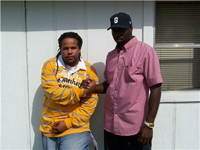
Over here on the other side of the table, Obii, are two extremely talented hip-hop artists from Goldsboro, North Carolina. Michael Clark a.k.a. Yahini the Elect and Jermaine Eaddy a.k.a. Reo Grand are Chozen Vesselz. Their debut album, Catch The Vision (2006), was actually recorded with a foursome. But in 2000, Yahini the Elect and Reo Grand decided to become a duo. They have a new EP, Chozen Onez, that was released last month. These gentlemen bring positive rhymes about spiritual and social issues ever present in the urban community and shining a light on many of those problems. Like Big Lo, they are telling it like it is, speaking a spiritual truth that urban audiences have never heard from any pulpit or storefront church. They lay their rhymes down against some fine old school DJ clips.
Keep chillin’, guys, the night’s young. Oh, hi, Jimmy. Let me loop my arm around yours and introduce you to these fine hip-hop artists. Do you guys all know Jimmy Mancus? He’s doing some really crazy things in Springbrook, Pennsylvania, that I think might raise a few of your eyebrows when you first hear it, but I think it will make you all give a nod to his work. Jimmy here is a singer/songwriter who’s brought in amped-up turntables and keyboards and enough unique rhythms to produce a rock sound that’s sometimes pure and at other times bordering on jazz and experimental tracks with tasty turntable effects. Over the top of all that are some very tight and very clever lyrics that always seem to make you feel good. He’s got a new CD out, Move Down, that came out in August, and is very different from his debut recording, Time to Shed Some Light on Me , from three years ago. It’s a mix of acoustic, indie, funk, hip-hop, rock, and surf…I think you gentlemen probably will have a lot to talk about.
http://www.sonicbids.com/epk/epk.aspx?epk_id=81541
There’s a big booth down here with some artists you have to meet. Let me introduce you to Adam Grant & Robert E. These country/southern rock artists are from Newnan, Georgia. Not only can they rock out as hard as Widespread Panic, but they can also spin a tender song like their “Clear Blue Water” or twang out a tune just like Waylon with a mix of electric guitars and banjos. That mix of electric and roots reflects the new country sound that is always a winning combination, especially when it is yoked to Adam’s powerful lead vocals and with Robert’s spot-on harmony vocals. These guys have opened for some of country’s biggies: Trace Adkins, Randy Travis, and Diamond Rio. Crowding out this table here is their band: Charlie Gilbert (lead guitar), Mike Deems (bass), Chris Mathis (drums), and Rodney Nunis (keys). These kick-butt musicians lay a great foundation for Adam’s and Robert’s guitars and vocals, which shine in their two albums, a self-titled CD and their latest, Country To The Bone.
http://www.myspace.com/randaproductions
In the next both is Dale Leroy Perry from Austin, Texas. He’s been on the road, carrying on the fine tradition of country blues with his guitar, taking his original songs from city to city. Along the way, Dale Leroy has worked in a steel mill, drove a cab, a seismic observer, and, of course, worked the oil fields. But through it all, he played music everywhere, even opening for Brownie McGhee and Sonny Terry in Austin years ago and getting a chance to even play a tune with them one night. Dale Leroy’s got a million stories—and a lot of them are in his songs. He sings as if he’s seen the armpit of the world as well as its most precious glories. He also picks a killer acoustic blues guitar and often performs with harmonica player Jimi Lee and bassist Larry Eisenberg. Dale Leroy Perry has three albums, Good and Ready, Moan My Name, and Live @ the Hyde Park Grill. (Look out, Ron, he’s got a white beard! You know I’ll be lingering at this table later and listening to some of his stories. Maybe I can coax him to sing a couple of songs for me. But I’ll be home, honey, don’t worry. Maybe I’ll invite him over, and you guys can pick awhile and swap your own songs and stories.)
http://www.sonicbids.com/epk/epk.aspx?epk_id=200050
Also at this booth, swapping his own stories with is Justin Levinson, a young singer/songwriter from Burlington, Vermont. An alum from the Berklee College Of Music in Boston, he’s earned songwriting awards, crossing over several genres, though he’s most often labeled as a pop artist, though that isn’t a good fit because he’s more a country/rock artist that slips and slides around all those labels. His debut album, 1175 Boylston, in 2005 got a lot of college radio airplay and Bury Your Love followed in 2007. Supporting him on those records, backing up Justin’s guitar, harmonica, keys, and vocals (and tonight they’re buying the first round) is his band: Sean Preece (drums and–surprise, a drummer doing backup vocals), Rob O’dea (bass), Brett Lanier (pedal steel), and Aaron Carlino (lead guitar). Justin has a lot more living to do and he’s going to right a boatload of songs about it all.
http://www.sonicbids.com/epk/epk.aspx?epk_id=64471
Farther along here at this quiet table in the corner are Anomie Belle and Patti Sterling. Toby Campbell who is the voice and embodiment of Anomie Belle hails from Seattle. She’s been performing and recording her own music since she was a wee thing, growing in her talent enough to work as a musician and music producer in Europe, New York, and Buenos Aires before settling in Washington state. She also is a film composer who has scored award-winning soundtracks for independent films showing in the Pacific Northwest and in Toronto. A multi-instrumentalist (keys, violin, and guitar), Campbell’s work is laced with layers of textures that are the perfect foil for her silky, sultry vocals that slide over the top of her precise programming. She is supported by Eric Otteson on drums and Dana Feder on cello. Anomie Belle’s debut album, Sleeping Patterns, that was released a year ago this month is pure ambrosia, a gift from the gods.
http://www.sonicbids.com/epk/epk.aspx?epk_id=171384
And the sweetheart sitting next to Anomie Belle is blues/jazz singer Patti Sterling from LA. She spent a turn in Texas, paying the rent and getting her cops in fine formation doing radio and commercials. She also did background work for Alex Harvey, Mike Settle, and Stevie Nicks, eventually opening for Ray Stevens, Clarence “Gatemouth” Brown, and Stevie Ray Vaughn. She formed her own band, Patti and the Satisfires, while she was in Texas and did the juke joints and roadhouse circuit. When she returned to LA, cut Bettin’ On You with KonKord Records in 2003, Borrowed & Blue with ArtistLaunch in 2006, and her latest Malibu Blues with Sterling Castle Music in 2008, who released her debut record Left Turn Only! back in 1997. Patti’s lush, vocal instrument produces a big sound but is able to seduce with its sultry sounds. Look out for this vocal dynamo. She’s going places fast.
http://www.sonicbids.com/epk/epk.aspx?epk_id=59837
As I said when we got our drinks, The Bhadra Collective from Toronto, Ontario, Canada, were setting up to do a brief set tonight. Though the SonicBids Lounge stage is tiny, they are managing to crowd all five of them and their truckload of instruments. They will be giving us a taste of their world spiritual music, which they state is designed to “uplift the heart and empower the feminine spirit.”
Dennis Gaumond, the founder of the group, gathered musical talent from various ethnicities and cultures who had an interest in world music, particularly chants. They come from African, First Nations Canadian, Palestinian, East Indian, Australian, and Eurpoean traditions and play as many as ten different ethnic instruments. Dennis, himself plays slide guitar, dobro, flute, harmonicas in odd keys, and does the lead vocals.
Other members are Vince Maccarone on drums and percussion, Jen Gilmor on bass and cello, Gary Diggins on didgeridoo, trumpet, flugelhorn, and percussion. All of these musicians also sing. Ed Majkut, who plays keyboards, doesn’t sing. The drums and percussion instruments are often hand drums of some variety, including doumbeks
The Bhadra Collective often blurs a lot of these world styles. For example, “Hare Yoni”sounds more like a gypsy tune but has South Asian lyrics, and “Wishi Ta” starts with a didgeridoo then adds drums and bass while the chorus sings a First Nations chant. Blues, rock, and roots music also seeps into the musical montage.
In the past three decades, before The Bhadra Collective, Dennis played in a variety of bands and recorded two CDs under the name, Dennis Gomo. He is also a founding member of the Canadian Association of Sound Healers and has presented Sacred Sound Workshops and seminars across Canada. These events include mantra, overtone singing, crystal bowls, chanting, and drumming.
Their debut CD, Soon Come Shekinah, was released in 2008 and is an absolutely delightful blend of world music that doesn’t dilute or distort the beauty of any but presents them in a fresh, new realm. I must admit that sometimes I get thrown by the vocals. I’m usually grooving so much on the instrumentation and expect it to proceed along a roots path that the South Asian lyrics seem to come out of left field. But after I take a breath, I want to sing along with The Bhadra Collective.
So, let’s grab this free table and flag down a waitress to refresh our drinks and give The Bhadra Collective a listen. I bet they won’t get through the first song before we get an oriental dancer out on the floor, inviting all of us to join in this happy dance of life….Don’t forget to drop on by next month.
Written By: Janie Franz – jfranz@skopemag.com

